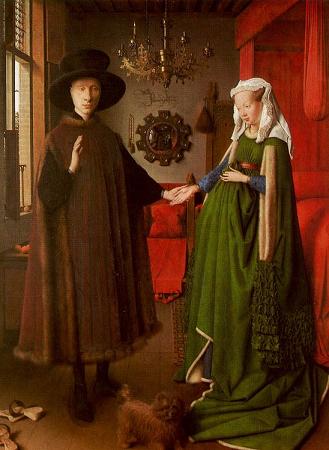Ghent Altarpiece (c1430). The Ghent Altarpiece is a large and complex 15th-century polyptych altarpiece in St Bavo's Cathedral, Ghent, Belgium. It was begun c. the mid-1420s and completed before 1432, and is attributed to the Early Netherlandish painters and brothers Hubert and Jan van Eyck. The altarpiece is considered a masterpiece of European art and one of the world's treasures. The panels are organised in two vertical registers, each with double sets of foldable wings containing inner and outer panel paintings. The upper register of the inner panels represent the heavenly redemption, and include the central DeŽsis of Christ the King, the Virgin Mary and John the Baptist. They are flanked in the next panels by angels playing music and, on the far outermost panels, the figures of Adam and Eve. The four lower-register panels are divided into two pairs; sculptural grisaille paintings of St John the Baptist and St John the Evangelist, and on the two outer panels, donor portraits of Joost Vijdt and his wife Lysbette Borluut. The central panel of the lower register shows a gathering of saints, sinners, clergy and soldiers attendant at an adoration of the Lamb of God. There are several groupings of figures, overseen by the dove of the Holy Spirit. The altarpiece is one of the most renowned and important artworks in European history. Art historians generally agree that the overall structure was designed by Hubert during or before the mid 1420s, probably before 1422, and that the panels were painted by his younger brother Jan. Yet, while generations of art historians have attempted to attribute specific passage to either brother, no convincing separation has been established, it may be that Jan finished panels begun by Hubert. The altarpiece was commissioned by the merchant and Ghent mayor Jodocus Vijd and his wife Lysbette as part of a larger project for the Saint Bavo Cathedral chapel. The altarpiece's installation was officially celebrated on 6 May 1432. It was much later moved for security reasons to the principal cathedral chapel, where it remains. Indebted to the International Gothic as well as Byzantine and Romanic traditions, the altarpiece represented a significant advancement in western art, in which the idealisation of the medieval tradition gives way to an exacting observation of nature and human representation. A now lost inscription on the frame stated that Hubert van Eyck maior quo nemo repertus started the altarpiece, but that Jan van Eyck, calling himself arte secundus, completed it in 1432. The altarpiece is in its original location, while its original, very ornate, carved outer frame and surround, presumably harmonizing with the painted tracery, was destroyed during the Reformation; it may have included clockwork mechanisms for moving the shutters and even playing music. The altarpiece was commissioned by the merchant Jodocus Vijd, then Mayor of Ghent, and his wife Lysbette, as part of a larger development project for the Saint Bavo Cathedral chapel. The installation of the altarpiece was officially celebrated on 6 May 1432; it was much later moved for security reasons to the principal cathedral chapel, where it remains. Art historians broadly agree that the overall structure was designed and built by Hubert in the early 1420s, and that most of the panels paintings were completed by his younger brother Jan between 1430 and 1432. Yet there has been considerable debate, and many art historians, especially in the mid 20th century, attempted to attribute specific passages to either brother.
more...














